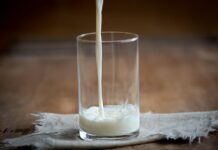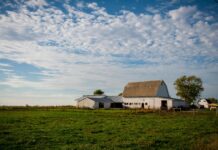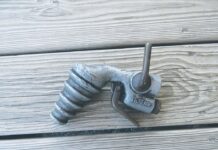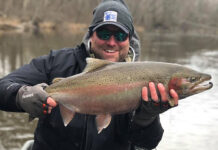Though most migratory song birds won’t arrive until April or May, March is a great month to tackle waterfowl identification. Binoculars and a field guide are the essential tools.
To find waterfowl, visit wetlands — lakes, farm ponds, beaver ponds, flooded meadows, and rivers, especially near dams. These are the habitats ducks frequent as they head north to nest.
The first thing to notice about a duck is how it behaves on the water. If it feeds on the surface by tipping its hind end into the air and stretching its neck beneath the water, it’s a dabbling or puddle duck. In taking flight, dabblers jump directly upward off the water.
If, on the other hand, a duck dives beneath the surface of the water to feed, it’s a diver, a group that includes canvasbacks, redheads, ring-necks, buffleheads, and mergansers. When divers take flight, they must patter along the surface to get airborne. That’s because their legs sit to the rear of the body to facilitate diving. This leg position makes divers ungainly on land, but they are excellent swimmers and divers.
Here’s a brief guide to the key characteristics of male ducks, including average weights, you might encounter on local waterways. Females are duller and require a bit more experience to identify, though in the spring they typically associate with drakes of their own species.
The Dabblers:
Wood duck (1.3 lb.) — note conspicuous slick-backed crest; multi-colored gorgeous bird; red eye ring, red bill; white throat and cheek markings; cavity-nester.
Mallard (2.4 lb.) — green head, white collar, yellow bill, chestnut breast, curly-cue tail, orange feet and legs, white tail.
American black duck (2.6 lb.) — suggests a very dark hen mallard; note the violet patch (speculum) on the wing, dark tail, yellow-green bill.
Gadwall (2 lb.) — drab; black butt; white belly; white and chestnut patch on wings in flight.
American wigeon (1.6 lb.) — white forehead and crown; green mask; white inner wing patch in flight.
Northern pintail (1.8 lb.) — chocolate brown head; white breast with narrow finger extending up neck; long pointed tail.
Northern shoveler (1.3 lb.) — green head; yellow eyes; large spatula-shaped bill; white breast; brown sides; powder blue shoulder patch in flight.
Teal — two species, both small; blue-winged teal (13 oz.) — powder blue shoulder patch in flight and wears an obvious white crescent on face; green-winged teal (12 oz.) — the smallest dabbler; chestnut head with green ear patch that extends down neck; green speculum.
The Divers:
Canvasback (2.7 lb.) — dark rusty head; profile of head angular; black breast; light-colored back; favors deep water.
Redhead — (2.3 lb.) rusty head; profile of head a bit concave rather than angular; breast black, back gray.
Ring-necked Duck (1.5 lb.) — poorly named; white ring near bill tip; head may appear pointed; gold eye; dark head, breast, and back; sides gray.
Scaups — two species, greater (2.3 lb.) and lesser scaup (1.8 lb.); distinguishing them is an advanced skill, consult a field guide; both have dark head and breast; gray back, and pale sides.
Common goldeneye (1.9 lb.) — dark head with round white cheek patch; gold eye; breast and sides white; cavity-nester.
Bufflehead (13 oz.) — small; dark head with large white bonnet; white breast and sides; cavity-nester.
Mergansers — three species; all have “toothed” bill for catching fish; common merganser (3.4 lb.) is large with green head with red bill; white body, black back; cavity-nester; red-breasted merganser (2.3 lb.) has green head with shaggy crest, wide white collar, and streaked rusty breast; hooded merganser (1.4 lb.) has black bill, black crested head; when crest is fanned, large white patch appears; gold eye; chestnut sides; cavity-nester.
Ruddy duck (1.2 lb.) — chunky compact duck; tail often cocked upward; head dark with large white cheeks; bill blue; body chestnut. On a really good day (if you’re lucky), you might see one of several species of sea ducks on larger lakes or rivers.
Harlequin duck (1.3 lb.) — strikingly marked; body primarily gray and white; chestnut sides visible when on water; conspicuous white markings on face and chest.
White-winged scoter (3.7 lb.) — large; all black with white eye spot and wing patches.
Long-tailed duck (formerly called oldsquaw) (1.6 lb.) — dark with white sides and belly; white patch around eyes; middle part of bill pink; long tail.













I have seen a brown duck like bird with a round brown spot on its breast. Have not been able to identify, does anyone have an idea of what it is?
Hi Doug,
The Ohio Division of Wildlife Waterbirds of Ohio book guidebook may help with bird identification: http://wildlife.ohiodnr.gov/portals/wildlife/pdfs/publications/id%20guides/pub418.pdf
We live in NE Alabama and have just moved to a Houston the Coosa River. We have many different birds but one especially has us tricked. They are with mallards and look just like mallards as far as size and shape and how the walk, but their color is different. They are black with a white breast. Any idea what these are? Thanks for your help!!